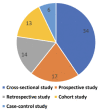Olfactory dysfunction among patients with COVID-19
- PMID: 37926445
- PMCID: PMC10712775
- DOI: 10.15537/smj.2023.44.11.20230264
Olfactory dysfunction among patients with COVID-19
Abstract
Objectives: To assess the frequency of olfactory dysfunction (OD) among individuals afflicted with coronavirus disease of 2019 (COVID-19).
Methods: A comprehensive literature search was carried out across several bibliographical databases (PubMed, Scopus, Google Scholar, and Web of Science) to extract publications in the English language between January 2020 and December 2021 to report the incidence of OD alone or together with gustatory dysfunction (GD) among COVID-19 patients.
Results: Based on eligibility criteria, 84 articles were included from 27 countries, comprising 36,903 patients, of whom 58.1% were females. The generality rates of olfactory impairment alone was 34.60% and in conjunction with GD was 11.36%. Patients with OD were subclassified into various categories, and the prevalence of anosmia was 20.85%, 5.04% for hyposmia, 8.88% for anosmia or hyposmia, 1.84% for parosmia, 0.78% for phantosmia, and 0.02% for hyperosmia, among COVID-19 patients.
Conclusion: Clinical features associated with OD, either isolated or in combination with GD, are common in patients with COVID-19 and consider important signs of COVID-19 that may guide clinicians in the early phase of the disease.PROSPERO Reg. No.: 417296.
Keywords: COVID-19; Hyposmia; SARS-CoV-2; anosmia; olfactory dysfunction.
Copyright: © Saudi Medical Journal.
Figures
Similar articles
-
Olfactory Dysfunction: A Highly Prevalent Symptom of COVID-19 With Public Health Significance.Otolaryngol Head Neck Surg. 2020 Jul;163(1):12-15. doi: 10.1177/0194599820926464. Epub 2020 May 5. Otolaryngol Head Neck Surg. 2020. PMID: 32366160 Review.
-
Epidemiological, otolaryngological, olfactory and gustatory outcomes according to the severity of COVID-19: a study of 2579 patients.Eur Arch Otorhinolaryngol. 2021 Aug;278(8):2851-2859. doi: 10.1007/s00405-020-06548-w. Epub 2021 Jan 16. Eur Arch Otorhinolaryngol. 2021. PMID: 33452919 Free PMC article.
-
Olfactory Dysfunction and Sinonasal Symptomatology in COVID-19: Prevalence, Severity, Timing, and Associated Characteristics.Otolaryngol Head Neck Surg. 2020 Jul;163(1):114-120. doi: 10.1177/0194599820929185. Epub 2020 May 19. Otolaryngol Head Neck Surg. 2020. PMID: 32423357 Free PMC article.
-
A systematic review and meta-analysis protocol examining the clinical characteristics and epidemiological features of olfactory dysfunction (OD) in coronavirus disease 2019 (COVID-19).Syst Rev. 2021 Mar 11;10(1):73. doi: 10.1186/s13643-021-01624-6. Syst Rev. 2021. PMID: 33691796 Free PMC article.
-
Olfactory Nomenclature: An Orchestrated Effort to Clarify Terms and Definitions of Dysosmia, Anosmia, Hyposmia, Normosmia, Hyperosmia, Olfactory Intolerance, Parosmia, and Phantosmia/Olfactory Hallucination.ORL J Otorhinolaryngol Relat Spec. 2023;85(6):312-320. doi: 10.1159/000530211. Epub 2023 Apr 14. ORL J Otorhinolaryngol Relat Spec. 2023. PMID: 37062268 Free PMC article. Review.
Cited by
-
Platelet-Rich Plasma (PRP) in the Treatment of Long COVID Olfactory Disorders: A Comprehensive Review.Biomedicines. 2024 Apr 5;12(4):808. doi: 10.3390/biomedicines12040808. Biomedicines. 2024. PMID: 38672163 Free PMC article. Review.
-
Maximizing Participation in Olfactory Training in a Sample with Post-COVID-19 Olfactory Loss.Brain Sci. 2024 Jul 21;14(7):730. doi: 10.3390/brainsci14070730. Brain Sci. 2024. PMID: 39061470 Free PMC article.
-
Evaluation of Olfactory Dysfunction Among COVID-19 Patients in Baghdad, Iraq.Cureus. 2024 Feb 6;16(2):e53721. doi: 10.7759/cureus.53721. eCollection 2024 Feb. Cureus. 2024. PMID: 38455837 Free PMC article.
-
Platelet-Rich Plasma for Patients with Olfactory Dysfunction: Myth or Reality? A Systematic Review.J Clin Med. 2024 Jan 29;13(3):782. doi: 10.3390/jcm13030782. J Clin Med. 2024. PMID: 38337476 Free PMC article. Review.
References
-
- Coronavirus WHO. (COVID-19) dashboard. [Updated 2023; accessed 2021 Dec 28]. Available from: https://www.who.int/emergencies/diseases/novel-coronavirus-2019
MeSH terms
LinkOut - more resources
Full Text Sources
Medical
Miscellaneous



